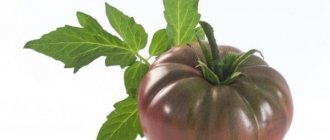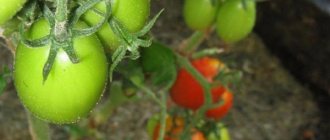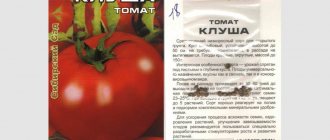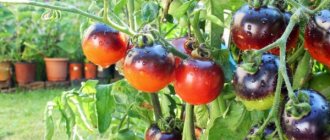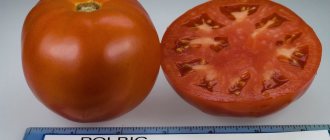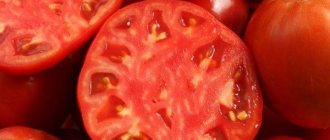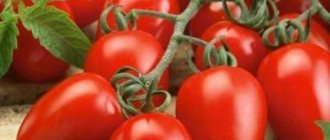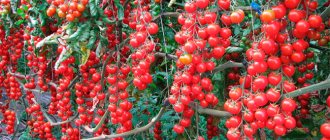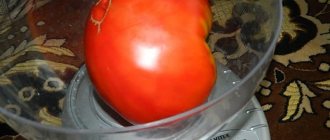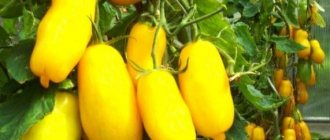Description and characteristics of the variety
Early ripening determinate variety Flame
Designed for growing in greenhouses, hotbeds and open ground, as it is not afraid of summer temperature changes. The bush has a compact, neat shape. The plant reaches a height of 60-80 cm. The bushes are distinguished by a strong trunk and stems.
Does not require pinching, tying or pinching the crown. From the moment of emergence of seedlings to the ripening of the fruits, 85-90 days pass.
T omata Flame
Simple inflorescences. The first is formed above the 8-9 leaf. Then it is formed every 1 or 2 sheets. Each inflorescence contains 4-5 flowers. The leaves are of normal shape, medium in size, and dark green in color.
The tomatoes are round, bright red or scarlet in color, which is where the variety gets its name. The sizes are small. The average weight is 60-80 grams.
According to tasters, Flame tomatoes have an excellent taste and a bright tomato aroma. The pulp is juicy, pleasant consistency, sweet with sourness.
The skin of tomatoes is smooth and shiny. There is ribbing on the surface. The thick skin protects tomatoes from cracking and preserves the juiciness of the fruit during long-term storage. But it can be easily removed if necessary.
The fruits are stored for 3-4 weeks if the rules are followed. Avoid drafts and high humidity in the room, maintain a constant temperature no higher than 19 degrees.
Tomatoes of the Flame variety can withstand long-term transportation without losing their attractive appearance and taste. Tomatoes are suitable for fresh food, as well as for making salads. But they can also be used in canning and pickling. Plants are unpretentious in care. They tolerate a lack of lighting and frequent planting on the site well.
Features of cultivation and storage
Cultivation is carried out by seedling method. Sowing is recommended to be done in the first or second ten days of April. The process of planting and caring for seedlings is standard and does not differ significantly from generally accepted agricultural cultivation techniques. When planting, experts recommend following the dates of the lunar calendar, which provides guidance for choosing the most favorable days for planting.
To prevent the formation of excess green mass, periodic work to remove stepsons is necessary. If they are removed incorrectly or insufficiently, the plant will experience a lack of nutrients, and the bulk of them will be directed to the formation of leaves, and not to the formation of fruits.
The advantage of growing this variety is its good tolerance to temperature changes and prolonged rains. Tomato productivity indicators practically do not decrease under difficult climatic conditions. Experienced gardeners note the plant’s good immunity to tomato diseases. The plant needs regular watering, loosening and feeding with mineral complexes.
Tomato Slavyanka is a variety of pink tomatoes with a determinant growth rate. The variety is included in the State Register of the Russian Federation for garden plots, household plots and small farms for cultivation under film covers. This type of tomatoes is suitable both for use in preparing salads and for whole-fruit canning.
Seeds collected independently in the fall must be properly preserved to prevent spoilage. And before planting, place in a weak solution of potassium permanganate for 20 minutes, then rinse with plain water.
Seed material is sown from the first days of April. Sowing pattern: 4 cm by 4 cm, depth 1.5 cm. Peat and sand are added to the soil, everything is mixed and laid out in containers. The seeds are placed in containers with soil and deepened a little. Water the soil carefully so that the seeds do not rise to the surface, then lightly compact the soil.
Tip: pre-soaked seeds will germinate much faster.
The emerged sprouts are transplanted into individual containers after the third leaf appears on the plant. Before transferring the seedlings to the garden, harden the seedlings for two weeks in a cool place; the temperature should not be lower than 10 degrees.
50 days after sowing, the seedlings are placed in open soil. By this time, one planting unit will have at least 7 strong leaves and one flower ovary, and the height of one plant will reach approximately 30 cm. The seedlings should have a green color, without yellowness, and a healthy appearance.
Mineral fertilizer, compost, peat, sand, and humus are poured into pre-prepared holes. Mix everything with soil to prevent burns to the roots and water with 1 liter of water.
To form bushes into one stem, overgrown stepsons of 3 cm or more are removed. It's better to do this in the morning. Without pinching, the plant will grow and the yield will drop.
In order for tomatoes to delight you with an abundance of harvest and large, tasty fruits, you need to follow the rules of care.
- As the bushes grow, it is necessary to garter.
- Remove lower foliage to allow the plant to grow unhindered and prevent disease. Remove 2-3 leaves once a week.
- Timely watering.
- In greenhouses the temperature is no higher than 22 degrees. During the process of fruit ripening, raise the temperature to 30 degrees. At a temperature of 15 degrees, flowering stops.
- Weed removal.
- Loosening the soil.
- Apply two organic fertilizers per season.
- If it is necessary to spray tomatoes, do it in the morning or evening.
The frost-resistant, mid-season tomato Slavyanin was created by breeders of the West Siberian Experimental Station. A distinctive feature of the variety is its pink-colored, pear-shaped fruits. Pink-fruited tomatoes have excellent taste and are traditionally classified as salad varieties. But the Slavic tomato is a pleasant exception, due to its ability to ripen in open ground, forming sweet, beautiful fruits of universal use.
Let's get acquainted in more detail with the characteristics and features of caring for the Slavyanin variety, as gardeners evaluate the tomato.
| Height | Landing location | Ripening time | Fruit color | Fruit size | Origin | Fruit shape |
| Medium height | Greenhouse, Open ground | Mid-season | Reds | Average | Variety | Flat-round |
Diseases and pests
The Flame variety is immune to most tomato diseases. Early ripeness and friendly ripening of tomatoes protects the plant from late blight.
But poor care and failure to comply with basic rules of agricultural technology can lead to problems even with the strongest and healthiest plant.
Therefore, to prevent diseases, constant timely care and disease prevention are performed.
To prevent diseases and protect against pests, plants are sometimes sprayed with a fairly effective folk remedy: garlic or onion infusion. Constant weeding and loosening of the soil is carried out, improving gas exchange, and excessive watering is not allowed. If tomatoes grow in greenhouses or greenhouses, constant ventilation is ensured.
If signs of the disease are detected, which are expressed in the withering of leaves, the appearance of rot, it is worth removing the affected areas and treating the bushes with special preparations.
With the appearance of slugs or caterpillars, pests will have to be removed from the bushes manually, then prevention will be carried out to prevent their reappearance. Sand, soda or ash are poured over each bush. This creates a barrier that prevents parasites from attacking the plant again.
What fertilizers are best for “Fire” tomatoes?
Reviews from experienced gardeners provide additional information on how best to care for this plant. Along with general impressions of growing tomatoes and using them in cooking, gardeners give practical advice on feeding the plant. They recommend the following types of fertilizers:
- Yara Vila;
- Planton P;
- Actiwin;
- Agro Nova.
Fact! Gardeners still practice fertilizers according to folk recipes. Among them, the most effective are bird manure, various tinctures based on nettle or wormwood, as well as ash solutions.
However, you should not get carried away with fertilizers that contain a high concentration of calcium, as this significantly increases the amount of chlorine in the soil. This does not have the best effect on the development of the plant, so it is recommended to use such fertilizers in small quantities.
Features of care
They do not require special care. Plants do not need pinching or shaping. Low, strong bushes do not need to be tied to a support. It is enough to carry out timely watering.
Water tomatoes only after the soil is completely dry, once a week. The bushes are watered early in the morning with settled warm water. Weed weeds in a timely manner.
Ensure gas exchange by loosening the soil. Hilling up bushes prevents erosion of the plant's roots.
Top dressing
Like any tomatoes, it loves light, fertile soil. If these are not available, fertilize several times a season. Give preference to mineral complexes enriched with phosphorus and potassium.
Be careful with nitrogenous fertilizers; nitrogen fertilizers slow down the formation of ovaries and the ripening of fruits. In the initial growing season, nitrogen fertilizers are suitable for plant growth, but then you should abandon them. Folk remedies in the form of infusions of cow manure, herbs and weeds, and chicken droppings are suitable as fertilizer.
To form strong ovaries, flowers are treated with a 1% boric acid solution.
After transplanting the seedlings to a permanent growing location, they are given two weeks to take root and adapt. During this time, no feeding is performed. Fertilizer and fertilizing are carried out three times a season, as needed.
An excess of substances affects no less negatively than their deficiency. If the plant looks good, blooms and bears fruit, the bush does not need additional elements.
How is the variety grown?
The plant is grown by seedling method. Planting of planting material begins in the first half of May. A mandatory requirement is sufficient nutritional value of the soil, which is recommended to be prepared from equal proportions of turf and humus. For disinfection, treatment is carried out with manganese or special devices.
Experts recommend planting seeds in peat tablets in an amount of 2 or 3 pieces, which allows you not to pick the seedlings in the future and leave strong shoots. When planting in a container with soil, deepening is carried out to a depth of 1 cm, sowing is carried out at a distance of 2 cm.
The optimal temperature for seedling growth during the day is considered to be 21-25 C°, at night from 15 to 18 C°. Watering is carried out only with warm water, and the room is periodically ventilated. Thinning is carried out after the appearance of 2 leaves, and after the formation of 3 leaves, diving is carried out. When transplanting sprouts after 10 days, it is necessary to feed the seedlings with mineral fertilizer. 3 weeks before transplanting into permanent soil, the bushes are hardened off.
Bushes are transplanted when the seedlings reach a height of 30 cm, since during this period the plant is able to form a sufficient root system. 6-8 plants are planted per 1 m2. A good place for planting is considered to be the soil after growing cucumbers, pumpkins, legumes and cereals.
Planting in soil with previous cultivation of tomatoes, potatoes or peppers is fraught with diseases of the shoots, since such species have a similar tendency to be affected by pests and diseases.
It is recommended to form bushes into 2 stems with periodic removal of stepsons up to 5 cm. Timely carrying out of stepsons helps to avoid dense plantings and increases productivity. The plant requires sufficient watering. To maintain soil moisture, it is recommended to use mulching with humus or straw.
Agricultural technology
Rules for growing seedlings
Sowing of seeds usually begins 50-55 days before planting seedlings in open soil.
Based on numerous reviews of Flame Agro tomatoes, you can be sure that the seeds of this variety do not have problems with germination, so growing seedlings is not a hassle.
Preparing seeds for planting:
- Before planting, the seeds should be soaked in a weak solution of manganese for half an hour. This allows for further planting to make the plant more resistant to fungus and parasites;
- Growth stabilizer – perfectly activates seed growth. To do this, just keep them in the liquid for 25-30 minutes. Afterwards, dry well.
Read also: How to make an insulated dog house
Preparations for planting are planted in containers with prepared soil. To prepare it, it is enough to take earth, coarse sand and peat in equal proportions. After moistening the soil, place a seed in it to a depth of 1 cm.
Subsequently, the containers are covered with plastic wrap and then placed in a place with good lighting. Usually this is a heated loggia or window sill. Such home greenhouses should be thoroughly ventilated. It is enough to open the film in the morning and close it at lunchtime. You can use a spray bottle to water the sprouts. It gently moistens the soil without damaging the shoots. Water with warm or cool water.
The most favorable temperature for tomato growth during the day is 20-25°C, and at night – 14-19°C.
After several leaves appear on the plant, it can be picked. Peat pots are perfect for this. You can plant the plant immediately in pots so that the Fire tomato seedlings adapt better and faster to the new environment. After transplanting the sprouts, after 10 days, fertilizing in the form of mineral fertilizers is required.
Planting a plant in open soil
It is recommended to plant seedlings in the second half of May. The main thing is that the earth has time to warm up and the weather outside is warm. Before planting, you should thoroughly plow the soil and apply fertilizer. 2-3 weeks before planting the seedlings in permanent soil, the bushes are hardened off.
No more than 6-8 seedlings should be placed per 1 m2. This variety has no special rules for caring for it. It is only important to water the plant regularly, apply mineral fertilizers on time and weed the beds.
The rules for caring for the Flame tomato are no different from agricultural techniques for other varieties.
Characteristics of tomatoes
The fruits have a pronounced elongated shape. The average length of vegetables reaches 13 cm. The fruits are distinguished by an unusual bright red color with the presence of orange veins, so the color of tomatoes resembles fire in appearance. The structure of the fruit is compacted, but the tomato skin is not characterized by increased rigidity. The following options for using vegetables are acceptable:
- eating fresh fruits in salads and everyday recipes;
- use in crushed form in the preparation of preparations in the form of juices, sauces, winter salads;
- preparation of marinades and preserves with whole fruit rolling.
Vegetables have a rich tomato flavor. The average weight of one Flame tomato reaches 150 grams. A characteristic feature of the variety is the presence of juicy pulp with a small content of seeds. The variety is gaining popularity due to its high yields, lack of shedding and cracking of fruits during ripening.
Reviews
Alexander:
“Fire is one of the best varieties of tomatoes. Growing hybrid greenhouse tomatoes will require taking into account certain nuances, but in general the agricultural technology turns out to be standard. I am confident that even beginners will be able to successfully cope with growing tomatoes and obtain a high-quality harvest.”
Caroline:
“Fire is my favorite early-ripening hybrid tomato variety. Proper growing of tomatoes involves taking into account standard agricultural practices. In any case, even novice gardeners can count on getting a good harvest.”
